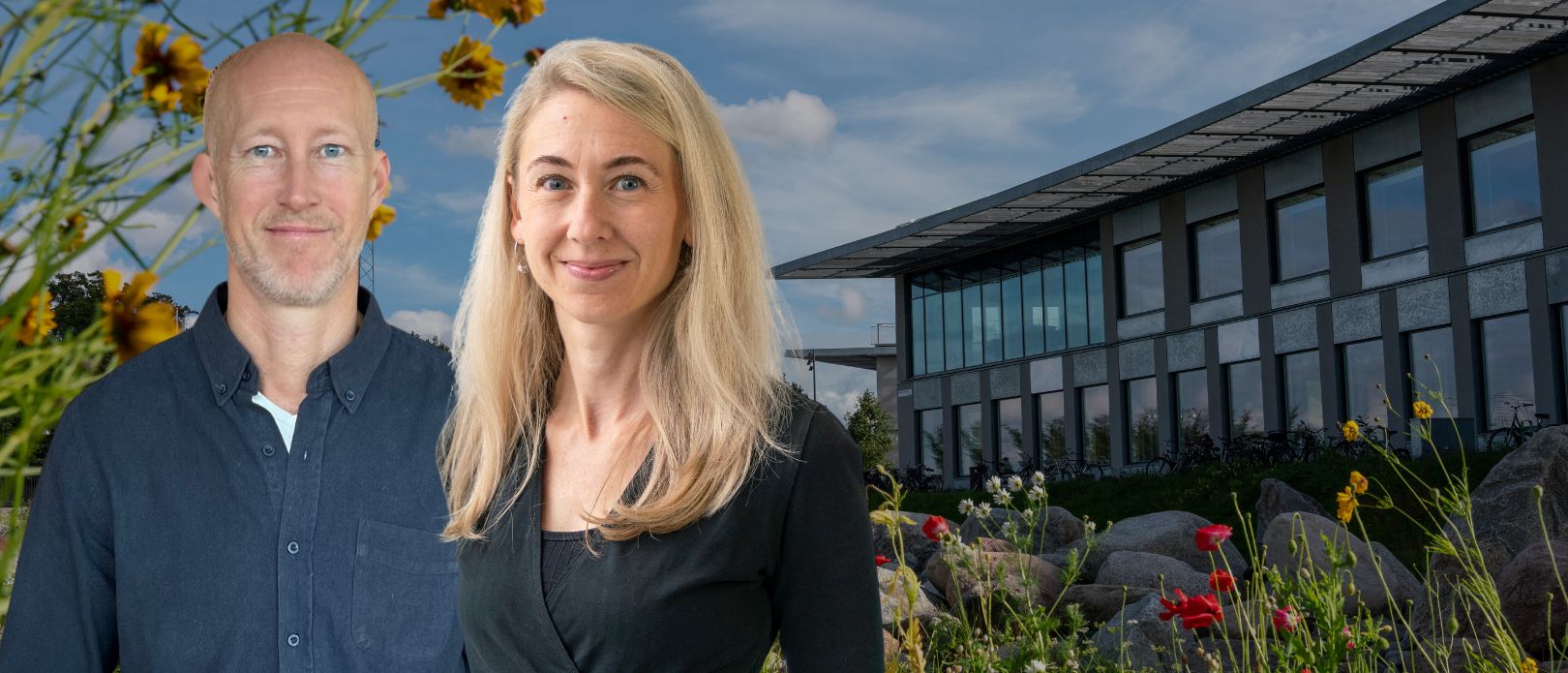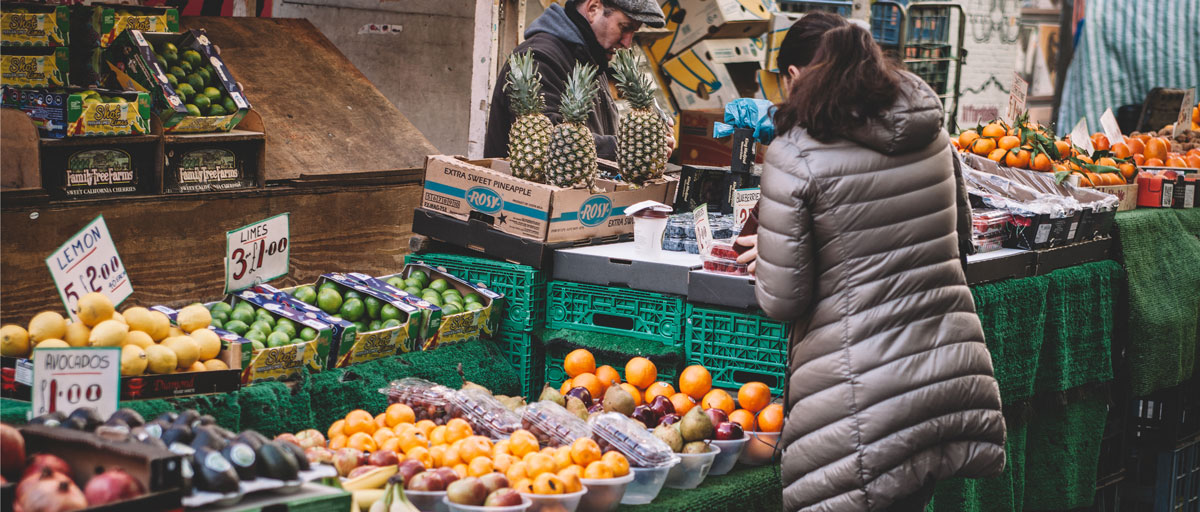A planetary lunch
Researchers and chefs team up for a sustainable lunch week

Food entrepreneur Dan Haneklint and food researcher Malin Jonell are part of a new collaboration. Photo: Stockholm Resilience Centre & Proviant.
“Risotto on Swedish oat-rice, with apple cider vinegar, blue mussels from Bohuslän, parsley, and grated Svecia cheese”. That’s one of the science-cooked dishes that guests can enjoy at “A Planetary Lunch” — an experimental lunch week at Stockholm university
- Food lies at the heart of healthy people, thriving societies, and a sustainable planet
- Four lunches for a life within the planetary boundaries were developed and are served during the inauguration week of Stockholm University's new campus Albano
- With the project, researchers and lunch restaurant Proviant hope to inspire guests, policy-makers and other restaurateurs
"We want to inspire everyone to eat better food, for ourselves and the planet," says Centre director Line Gordon.
Food lies at the heart of healthy people, thriving societies and a sustainable planet. But food is also a major contributor to greenhouse gas emissions and loss of biodiversity. Unsustainable agriculture production is a major driver of crossing the planetary boundaries.
"The science is clear: food systems must change rapidly for humanity to live healthy and develop sustainably," says Centre researcher Malin Jonell, theme leader for the Food for Resilience research theme at the Centre.
We want to inspire everyone to eat better food, for ourselves and the planet.
Centre director Line Gordon
Building on the opening of a new and sustainable university campus, Albano, in Stockholm, food researchers at Stockholm Resilience Centre teamed up with Restaurant Proviant to cook up a sustainable lunch week that showcases the most up-to-date food research.
"This is a very exciting project for us as a restaurant where we get to work with the latest research findings and put theory and science into practice, directly on our menus. We are good at working with sustainability issues on a daily basis, for example through our menu planning and in food waste issues. But in this project, there are also ingredients that we do not work with very often. It is both challenging and inspiring” says food entrepreneur Dan Haneklint, head of Proviant.
With the project, the researchers and Proviant hope to inspire guests, policy-makers and other restaurateurs to eat more scientifically and make sure sustainability is at the core of producing and eating food.
This is a very exciting project for us as a restaurant where we get to work with the latest research findings and put theory and science into practice, directly on our menus.
Food entrepreneur Dan Haneklint, head of Proviant
For the inauguration, four lunches were developed for a life within the planetary boundaries. In the restaurant, guests can listen to and chat with chefs and food researchers about the menu of the day.
“This project is really food for thought, we want each day’s lunch dish to be an appetizer that creates room for open-hearted conversations. Food is surrounded by myths and misunderstandings, and we hope our joint project will help us have better and balanced dialogues around what we eat and how it is impacting our planet,” says Line Gordon.
“What we choose to eat is very much about habits. We, both our employees at the restaurant and our guests, all need to get used to new ingredients by being curious and our role is to dare to introduce the food and of course, make it really tasty” concludes Dan Haneklint.
A planetary lunch menu
Recipes for all four lunches can be found here » Pdf, 82.2 kB.
Pdf, 82.2 kB.
Day 1: Blue food — more than fish in the ocean
“Risotto” on Swedish oat-rice, with apple cider vinegar, blue mussels from Bohuslän, parsley, and grated Svecia cheese
When it comes to food from the sea, most of us in Sweden only eat four or five species. Increasing the diversity of species we eat can be better for both the environment and our health! The benefits depend greatly on how our seafood is grown or caught, according to SRC research. For example, the farmed blue mussels on your plate have lower than average carbon emissions compared to any other meat or seafood, they contain high levels of key nutrients, and provide the ecosystems with filtered water and habitats for young fish.
Learn more: The Blue Food Assessment »
Day 2: Less but better meat
“Boeuf bourguignon” with grass-fed beef, served with pickled red onion, sautéed mushrooms, and carrots from Gotland boiled with sea buckthorn
Most high-income consumers eat more meat than what is sustainable - for climate, land, biodiversity and animal welfare. Swedish meat consumption has increased by 70 % since 1960 because it’s affordable, and many also value its tastiness, familiarity and convenience. But changing this, here and elsewhere, is crucial for food system sustainability. To eat ‘less but better’ meat is a pragmatic way to change: eat meat occasionally, when you do, choose things like the pasture-fed beef (‘naturbeteskött’) that is currently on your plate!
Learn more: The effects of less, but better meat production »
Learn more: Why consuming meat sustainably is harder than you think »
Day 3: Pulses – good for people and the planet
Falafel based on Swedish heritage grey peas, with cauliflower rice, a butter bean spread, fermented red cabbage, roasted broccoli, a vegan siracha mayo, and garlic sauce, all topped with roasted hazelnuts
Humans have cultivated legumes for millennia for their nutrition and environmental benefits. Grey peas were widely grown in Sweden as human food and animal feed until the late 1800s when they were replaced with green and yellow peas. There is a resurgence of interest in grey peas due to their deep ties to the Swedish culture and landscape as well as taste, texture and soil-enhancing ability. How we eat legumes – as whole beans, lightly processed (such as falafel) or meat replacement products – impacts how our bodies use the nutrients and how affordable the meals are.
Learn more: How the humble bean can help the World »
Learn more: EAT-Lancet report "The planetary health diet" »
Day 4: Eat the landscape, shape the landscape
Roasted pointed cabbage with fried Swedish heritage grey peas and Swedish autumn apples, served together with a stew of autumn mushrooms, Swedish whole wheat, and Västerbotten cheese
What we choose to eat affects people and landscapes locally and globally. To support landscape and human health, we need to increase the share of plant-based proteins on our plates.
A delicious way of doing so is by eating a combination of whole grains and legumes.
In the landscape, legumes support soil health and provide important nutrients that different grains need to grow. On our plate, their different nutritional profiles complement each other and provide the perfect combination of essential amino acids that meet your protein needs!








